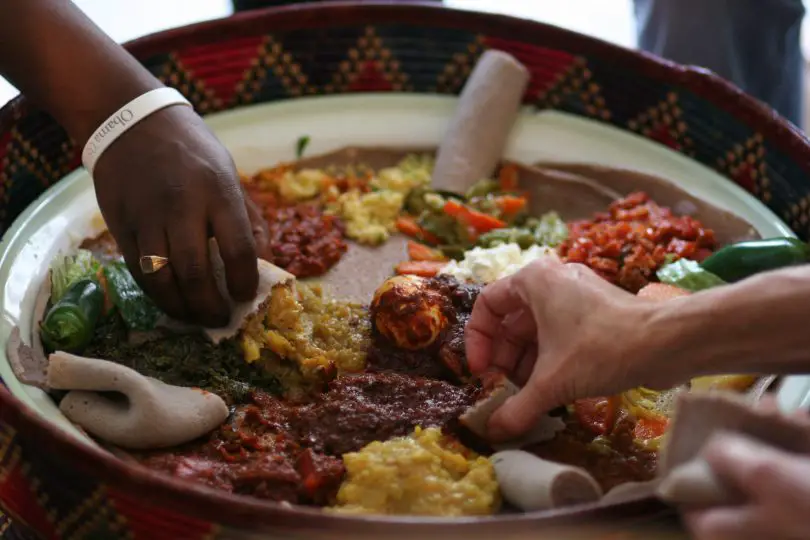Ethiopians take great pride in preserving their traditional heritage with their unique Ethiopian Food facts. Eating food is much like a ceremony, with everyone sitting around the table and slowly savouring the tasty meal.
Ethiopian food contains vegetables and spicy meat stews and sauces. Other popular Ethiopian foods include flatbread, which is called Injera. Pulses such as lentils or chickpeas, beans or corn are also common in dishes as are beef, lamb and fish.
Table of Contents
What is Ethiopia’s Famous Food?

Injera-Flat bread, Ethiopian food facts. Photo/willflyforfood.net
- Injera: large sourdough flatbread made with teff flour. Teff is an Ethiopian cereal.
- Tips: sauteed and fried meat and vegetables.
- Kitfo: spice-marinated minced raw beef.
- Wat: meat or veggies combined with sauteed onions and spices
- Genfo: classic morning food that is produced from wheat or barley.
What Makes Ethiopian Food Unique?
-
Flavors of Ethiopia

Berbere-Ethiopian Food facts. Photo/ amazon
The most important Ethiopian food fact is that they prepared it with a distinctive flavor for an unforgettably striking dimension to exotic cookery.
They took flavor to a whole new level, using fragrant spices that add an exotic taste to the food. One of the most common seasonings is berbere. Berbere is a blend of spices such as cinnamon, cardamom, ginger, sacred basil, and other spices that create a unique flavor you won’t taste anywhere else.
Other spices used in many Ethiopian dishes include turmeric and mitmita.
2. Injera–The Ethiopian Flatbread

Injera. Photo/Hedonism eats
Injera is Ethiopia’s national dish, made with teff flour, an Ethiopian grain.
They use this flatbread as the base for most Ethiopian meals. While eating Injera, eat with your hands, to scoop up delicious stews, lentils, and meats.
Much like a sourdough flatbread, they ferment Injera for three days before being fried on a griddle. This delicacy has a slightly tangy taste, with a texture much like a pancake.
In most Ethiopian homes and restaurants, you’ll find Injera laid out on a plate, topped with a variety of stews, salads, and cooked vegetables.
3. Spicy Meat Dishes

Ethiopian Food facts. Photo/Eleni’s Kitchen
A staple with meat dishes is Tibs. These are small pieces of meat that are sauteed with rosemary twigs and onion in spiced butter.
Don’t let the simplicity of Tibs fool you. It’s delicious served on Injera, along with other spiced lentils.
Another meat favorite in Ethiopia is Kitfo. This is beef tartare, made with raw beef blended with hot and spicy chilli powder.
Before you say that raw beef isn’t for you, think again. With its perfect amount of spice, Kitfo will melt in your mouth.
4. Savory and Spicy Stews
These stews, referred to as Wat, are Ethiopia’s distinctive cuisines. It is a common dish in Ethiopia made with chicken, beef, or goat, but the basic taste idea remains the same. Wat is a hearty stew that takes hours to prepare slowly on low heat so that the spices and tastes can meld together.
Doro wat is a type of Wat that uses chicken breast as the main ingredient and berbere spice to flavor a sweet and sour onion sauce. When on tour in Ethiopia, try to locate a restaurant that serves this dish since it takes some time to cook.
5. Ethiopian Vegetarian Dishes
Ethiopian cuisine won’t let you down if you’re seeking a vegetarian choice. There are various Ethiopian food facts about traditional meatless recipes that you can choose from.
One of these recipes is shiro, a stew prepared with tomatoes, onions, berbere, and garlic. Although it can be served alone, shiro is best included in mixed vegetarian platters like the Yetsom Beyaynetu plate.
Another popular vegetarian option in many Ethiopian restaurants is Misir Wat. This red lentil stew has a moderate amount of spice. Using sauteed onion, garlic, cardamom, and berbere spice, Misir Wat slowly simmers to produce a wonderful and delicious vegetarian stew.
6. Dining Ethiopian Style
Besides all these classic Ethiopian food facts, food is not to be eaten alone. Ethiopian food is best served on a communal platter designed for sharing food with friends and family. Also, attempt to follow the cultural tradition of only eating with your hands.
Ethiopians only eat with their right hand because they believe their left hand is unclean. However, if you are not familiar with using your hands, many eateries would provide you with a fork and knife.
7. Ethiopian foods are healthy
Another Ethiopian food fact is that the dishes are good for health because they don’t include undesirable ingredients in the recipes. For example, they make Injera from Teff. It’s gluten-free, iron-rich, and healthy for the body. It doesn’t have high calories and still keeps you full.
These Ethiopian foods also have raw and fresh vegetables as the main ingredients which are great for our health.








